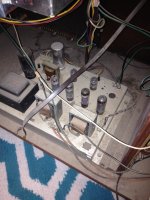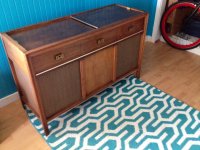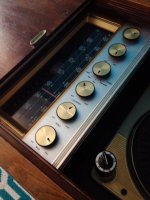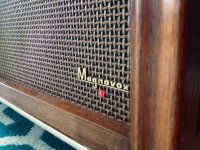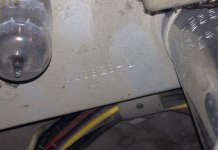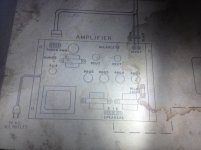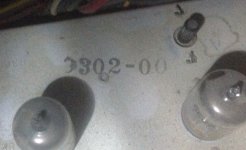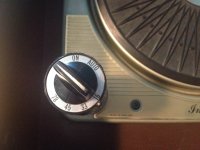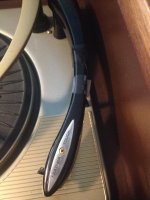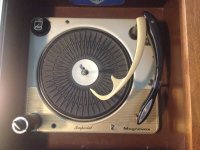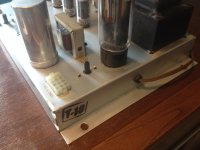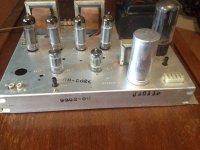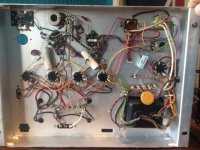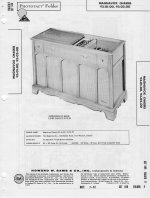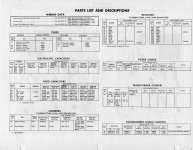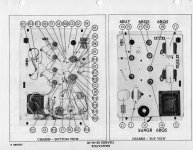Hello diyAudio,
This is my very first post to this forum. I am new to tube amps so I'm in need of some help. I was at a flea market today and I came across an old Magnavox console stereo system for 40$ and couldn't pass up on it. The turn table is a bit beat up, but the rest of the console is relatively clean. I had the guy turn it on there and it seemed to be a fair deal for 40$.
So I got it home and started in on diagnosing some issues. The AM/FM tuner works great, but the turn table needs some serious work. I'll probably end up replacing the entire turn table eventually. Found a few of them in mint on eBay for under 100$.
The receiver has a few extra inputs, so I located the inputs inside and plugged a secondary turn table into it to get some clean sound coming in. The right channel barely works, and is mostly gargled and crackling, but the left works semi decent (it has a bit of distortion at higher volume). I plugged some generic bookshelf speakers into the bypass in the back, and changed the speaker selector over. The result was the same. I then bypassed the receiver and plugged it directly into the amp, and had the same result. So the issue is in the amp.
In my research, I've found that the amp resembles an EL84 piece for piece, but I'm not 100% sure. Fortunately the factory wiring diagram is still taped inside for some help in identifying the different tube types. So where should I start with getting this thing functional again? Any help is greatly appreciated!
This is my very first post to this forum. I am new to tube amps so I'm in need of some help. I was at a flea market today and I came across an old Magnavox console stereo system for 40$ and couldn't pass up on it. The turn table is a bit beat up, but the rest of the console is relatively clean. I had the guy turn it on there and it seemed to be a fair deal for 40$.
So I got it home and started in on diagnosing some issues. The AM/FM tuner works great, but the turn table needs some serious work. I'll probably end up replacing the entire turn table eventually. Found a few of them in mint on eBay for under 100$.
The receiver has a few extra inputs, so I located the inputs inside and plugged a secondary turn table into it to get some clean sound coming in. The right channel barely works, and is mostly gargled and crackling, but the left works semi decent (it has a bit of distortion at higher volume). I plugged some generic bookshelf speakers into the bypass in the back, and changed the speaker selector over. The result was the same. I then bypassed the receiver and plugged it directly into the amp, and had the same result. So the issue is in the amp.
In my research, I've found that the amp resembles an EL84 piece for piece, but I'm not 100% sure. Fortunately the factory wiring diagram is still taped inside for some help in identifying the different tube types. So where should I start with getting this thing functional again? Any help is greatly appreciated!
Attachments
Look for and report back with the numbers printed on both chassis. That info. will enable member Tom Bavis to dig the schematic out of his extensive collection.
It looks like you have push/pull EL84/6BQ5 O/P tubes and 12AX7 small signal tubes. IIRC, "MaggotBox" liked paraphase splitters and a 12AX7 can be set up that way.
It looks like you have a 5U4GB rectifier, which provides B+ to both the amp and the tuner-preamp.
The photos suggest that the unit has never been retubed. Rectifiers last decades, but the signal tubes could be worn out.
A stock sing/song applies to all units this old. ALL electrolytic capacitors should be replaced, as they have literally dried out over time. Signal path caps. probably should go too. 716P series "Orange Drops" are suitable signal path parts.
Carbon composition resistors should be checked for drift and replaced with carbon film parts, when necessary. Unless signs of mechanical breakdown are present, leave wirewound resistors alone.
It looks like you have push/pull EL84/6BQ5 O/P tubes and 12AX7 small signal tubes. IIRC, "MaggotBox" liked paraphase splitters and a 12AX7 can be set up that way.
It looks like you have a 5U4GB rectifier, which provides B+ to both the amp and the tuner-preamp.
The photos suggest that the unit has never been retubed. Rectifiers last decades, but the signal tubes could be worn out.
A stock sing/song applies to all units this old. ALL electrolytic capacitors should be replaced, as they have literally dried out over time. Signal path caps. probably should go too. 716P series "Orange Drops" are suitable signal path parts.
Carbon composition resistors should be checked for drift and replaced with carbon film parts, when necessary. Unless signs of mechanical breakdown are present, leave wirewound resistors alone.
Thank you for the response!
Yeah all the tubes look to be all original.
I will post some pictures of the numbers I found. I was only able to find two different numbers (other than the model of tubes engraved next to each tube) one was stamped in ink, the other engraved. I am also attaching a picture of the diagram that is inside the console. Thanks again!
Yeah all the tubes look to be all original.
I will post some pictures of the numbers I found. I was only able to find two different numbers (other than the model of tubes engraved next to each tube) one was stamped in ink, the other engraved. I am also attaching a picture of the diagram that is inside the console. Thanks again!
Attachments
Hi,
Maybe something is wrong with end stage - 4 x 6BQ5 or preamp stage /small tubes/. It's work for someone with practice with tubes PP stages without schematic. If You found the schem, it's better, but schem doesn't have modes of tubes. For You it's hard problem. I understand Your problem, but I'm very far.
Maybe something is wrong with end stage - 4 x 6BQ5 or preamp stage /small tubes/. It's work for someone with practice with tubes PP stages without schematic. If You found the schem, it's better, but schem doesn't have modes of tubes. For You it's hard problem. I understand Your problem, but I'm very far.
For a console amp, the unit in question is "top shelf".
The triodes in a 6EU7 are the same as those as in a 12AX7. The difference between the 2 types is pin out.
IMO, refurbishing the amp is a given. It could be used with a different preamp. The tuner/preamp is a bit tricky. Replacing tubes most definitely means alignment and a sophisticated test bench is needed to get that job done.
PP 6BQ5s should yield approx. 15 WPC. That's enough for quite a few commercial speaker offerings. As the O/P transformers are not massive, don't expect to reach the 1st octave. That's probably NBD. Look for small to medium sized speakers whose sensitivity is at least an honest 90 dB.
The triodes in a 6EU7 are the same as those as in a 12AX7. The difference between the 2 types is pin out.
IMO, refurbishing the amp is a given. It could be used with a different preamp. The tuner/preamp is a bit tricky. Replacing tubes most definitely means alignment and a sophisticated test bench is needed to get that job done.
PP 6BQ5s should yield approx. 15 WPC. That's enough for quite a few commercial speaker offerings. As the O/P transformers are not massive, don't expect to reach the 1st octave. That's probably NBD. Look for small to medium sized speakers whose sensitivity is at least an honest 90 dB.
You can email me for a schematic of the 93xx amp with better detail - tbavis(at)rochester(dot)rr(dot)com. I probably have the tuner schematic as well, but would need a chassis number - maybe 76xx series.
The coupling caps are often upped in value, which won't help the low-frequency response (determined by the output transformer) and may cause oscillation (motorboating). The example linked has a poor choice - the same time constant for both pairs of R-C values - 0.047/470 K and 0.1/220K. This will result in a gain increase below 40 Hz - which will cause bass distortion, since the transformer doesn't go that low. The "paraphase" inverter circuit should use coupling caps in at least a 5:1 ratio - Magnavox used various values, this one is 15:1. (.0015uF to .047uF).
Changing from a single cathode resistor for all four tubes to a resistor per pair will allow the use of matched pairs of EL84s, rather than a matched quad. Mismatched output tubes will limit output, increase distortion, especially at low frequencies.
The coupling caps are often upped in value, which won't help the low-frequency response (determined by the output transformer) and may cause oscillation (motorboating). The example linked has a poor choice - the same time constant for both pairs of R-C values - 0.047/470 K and 0.1/220K. This will result in a gain increase below 40 Hz - which will cause bass distortion, since the transformer doesn't go that low. The "paraphase" inverter circuit should use coupling caps in at least a 5:1 ratio - Magnavox used various values, this one is 15:1. (.0015uF to .047uF).
Changing from a single cathode resistor for all four tubes to a resistor per pair will allow the use of matched pairs of EL84s, rather than a matched quad. Mismatched output tubes will limit output, increase distortion, especially at low frequencies.
Thank you for all the input! I pulled out the amp and cleaned it up some to get cleaner pictures.
-luckythedog: I'll post some pics of the actual table. The speed control seems to be messed up, and the arm is totaled. Other than that it plays just fine.
-Tom: Thank you, I will e-mail you for further info. I am having trouble locating the chassis number. I have found other number series but nothing like a 76xx series number.
-Eli: So where should I start first? I can source all the tubes locally, would that be the best start?
Pictures of additional numbers found
-luckythedog: I'll post some pics of the actual table. The speed control seems to be messed up, and the arm is totaled. Other than that it plays just fine.
-Tom: Thank you, I will e-mail you for further info. I am having trouble locating the chassis number. I have found other number series but nothing like a 76xx series number.
-Eli: So where should I start first? I can source all the tubes locally, would that be the best start?
Pictures of additional numbers found
Attachments
Obviously, a LOT of work is needed. We definitely need the good schematic from Mr. Bavis. The schematic will guide the refurbishing.
The OEM power cord goes and is replaced by a modern, 3 wire, safety grounded, cable. The multi-section can cap. has to go. Let's look before leaping. Be patient, until the good schematic can be perused.
The OEM power cord goes and is replaced by a modern, 3 wire, safety grounded, cable. The multi-section can cap. has to go. Let's look before leaping. Be patient, until the good schematic can be perused.
For sure a wise decision. I e-mailed him a bit ago, but I'm still not sure of the chassis number.
I have found some other numbers since pulling the amp out, but I don't know exactly what I'm looking for. I've found :
T-10, stamped on the side
316113, stamped on the front
636826-4, engraved on the top next to the 9302-00 that is stamped
I have found some other numbers since pulling the amp out, but I don't know exactly what I'm looking for. I've found :
T-10, stamped on the side
316113, stamped on the front
636826-4, engraved on the top next to the 9302-00 that is stamped
I wouldn't automatically assume that all the tubes need to be replaced. As stated above, assume that the power supply caps need to be replaced, and probably the coupling caps, and some other things. But depending upon the length of use, the output tubes could be okay, and if previously replaced, possibly the rectifier tube.
Try to find someone with a good tube tester. I'd bet that the 6EU7's are fine.
Try to find someone with a good tube tester. I'd bet that the 6EU7's are fine.
I'd bet that the 6EU7's are fine.
Sucker bet!
Nice. Reminds me of a Lenco GL58 from late 50s early 60s. It's not the lenco, but just on its looks seems like a keeper to me, and in the fullness of time you might get in to restoration. Ignore common wisdom that those arms track too heavy, they're fine for period records (and modern stuff too) IME, and the whole thing sounds 'authentic' and you'll be amazed at how well they track once one overcomes the barrier of heavy tracking - IME it doesn't damage records when well set up.-luckythedog: I'll post some pics of the actual table. The speed control seems to be messed up, and the arm is totaled. Other than that it plays just fine.
I'd also keep the original valve/tube line up unless they are definitely duff. Wouldn't change them on speculation, probably beat the new stuff anyway, and if you buy NOS it's been sitting about anyway, which is not harmful necessarily. Tubes don't necessarily age by sitting about, and again there's a certain authenticity with the originals. I try hard not to change original glass - I'm sitting here listening to an 8 valve/tube tuner/amp arrangement all of which are original from 1961 and I use daily, personally I've clocked 1000s of hours on.
Enjoy !
New Sensor is currently making 6EU7s,
I found it hard to believe that these are still being made, so I looked it up. Waaa-hooo! yep--only $51.07 per copy at New Sensor's site.
......better convert to 'ax7's!
- Status
- This old topic is closed. If you want to reopen this topic, contact a moderator using the "Report Post" button.
- Home
- Amplifiers
- Tubes / Valves
- Help with Magnavox EL84 Console restore
